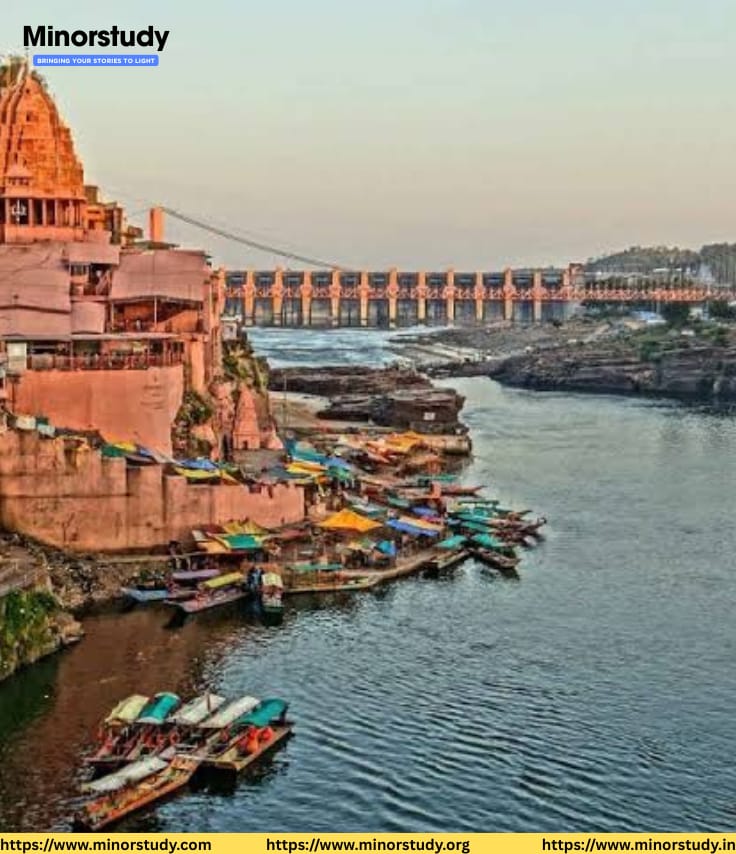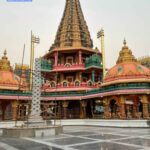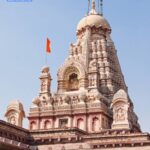🕉️ Omkareshwar Temple: The Island Shrine Where Divinity Dwells in Every Breath
Omkareshwar Temple: Tucked away in the spiritual heartland of Madhya Pradesh, on a serene island formed by the sacred Narmada River, lies the Omkareshwar Jyotirlinga—one of the 12 Jyotirlingas that are considered the most powerful abodes of Lord Shiva. Omkareshwar isn’t just a temple—it is an experience. A space where devotion flows as gracefully as the river around it. A place where history, faith, and daily life merge seamlessly.
- 📜 History of Omkareshwar Temple
- 📌 7 Divine Facts About Omkareshwar Temple
- 📅 Timeline of Omkareshwar Through the Ages
- 🙏 Significance of Omkareshwar in Hinduism
- 🌄 Observances, Rituals, and Festivals
- 💬 FAQs About Omkareshwar Temple
- Q1: What is the difference between Omkareshwar and Mamleshwar?
- Q2: Is it true that the island is shaped like Om?
- Q3: How can one reach the temple?
- Q4: Are women allowed inside the sanctum?
- Q5: Can one stay overnight near the temple?
- 🌠 Wishing for Devotees
- 🌿 Importance in Our Life and Society
- 🧭 Important Points for Devotees
- 🧘 Daily Life Impacts
- 🏁 Conclusion: Omkareshwar is a Pilgrimage of the Heart
This article takes you through Omkareshwar Temple’s history, significance, rituals, timeline, and its impact on daily and social life, all in a human-friendly tone designed for those who seek divine knowledge in a modern world.
📜 History of Omkareshwar Temple
The origins of Omkareshwar are steeped in Vedic legend and spiritual symbolism. The temple is located on the Mandhata Island, shaped naturally like the sacred syllable “ॐ” (Om)—a fact that lends the temple its name. The sacredness of the site goes back to:
🔸 Mythological Roots:
According to Shiva Purana, once a great war occurred between the Devas (gods) and Danavas (demons). When the gods were about to lose, they prayed to Lord Shiva, who manifested himself as Omkareshwar Jyotirlinga and granted them victory.
Another legend involves King Mandhata of the Ikshvaku dynasty, who performed great penance here. Lord Shiva was so pleased that he manifested in the form of a Jyotirlinga, hence the name Mandhata Island.
📌 7 Divine Facts About Omkareshwar Temple
| 🧭 Aspect | ✨ Fact |
|---|---|
| Location | Mandhata Island, Khandwa District, Madhya Pradesh |
| Deity | Lord Shiva as Omkareshwar (Lord of Om) |
| Form | One of the 12 Jyotirlingas |
| Special Feature | Island shaped like ‘ॐ’ (Om) |
| Other Temple | Nearby Mamleshwar Temple is equally revered |
| River | Narmada River encircles the island |
| Worship Style | Traditional Shaivism with Rudrabhishek & Aarti |
📅 Timeline of Omkareshwar Through the Ages
| 📆 Period | 🧾 Event |
|---|---|
| Ancient Era | Mentioned in the Skanda Purana, connected to Mandhata |
| 7th Century | Flourished during the rise of Shaivism in Central India |
| 11th Century | Supported by Paramara kings and later by the Marathas |
| 18th Century | Maratha rulers renovated the temple complex |
| Modern Era | Declared a national pilgrimage site, with improved infrastructure and the Omkareshwar Dam enhancing access |
🙏 Significance of Omkareshwar in Hinduism
Omkareshwar holds a dual manifestation of Lord Shiva:
Omkareshwar (Lord of Om – abstract and spiritual form)
Mamleshwar (Amaleshwar – Lord of the physical and manifest form)
Together, they represent the duality of existence—body and soul, matter and spirit. This duality also reflects Shiva’s nirguna-saguna nature: both formless and with form.
The island’s “ॐ” shape is rare in world geography and spiritually symbolic. It reflects the primordial sound of the universe and aligns with yogic and Tantric philosophies.
🌄 Observances, Rituals, and Festivals
🔥 Daily Worship
Rudrabhishek with milk, bel leaves, and holy water.
Mangala Aarti, Shringar Aarti, and Sandhya Aarti are performed with traditional music and mantras.
🌕 Special Festivals
Mahashivratri: Devotees keep an all-night vigil and perform elaborate Shiva pujas.
Shravan Month: Pilgrims perform Narmada Parikrama and chant “Har Har Mahadev” while offering sacred waters.
Kartika Purnima: Marks spiritual cleansing through dips in Narmada and temple rituals.
💬 FAQs About Omkareshwar Temple
Q1: What is the difference between Omkareshwar and Mamleshwar?
A: Both are considered sacred Jyotirlingas—Omkareshwar symbolizes Shiva in his spiritual form, while Mamleshwar represents his manifest form.
Q2: Is it true that the island is shaped like Om?
A: Yes. Aerial images and ancient geographical records confirm the island resembles the symbol “ॐ”.
Q3: How can one reach the temple?
A: You can walk across the suspension bridge (Jhula Pul) or take a boat ride across the Narmada from the mainland.
Q4: Are women allowed inside the sanctum?
A: Yes, unlike some temples, both men and women can offer prayers close to the Shiva Linga.
Q5: Can one stay overnight near the temple?
A: Yes. There are several dharamshalas, ashrams, and hotels within walking distance.
🌠 Wishing for Devotees
“May Omkareshwar’s sacred vibrations echo within your heart and lead you to peace, power, and purpose. Har Har Mahadev!”
Whether you are offering prayers or walking the island, each step at Omkareshwar feels blessed. It is said that Shiva calls his devotees, and once visited, the echo of “Om” never leaves your soul.
🌿 Importance in Our Life and Society
🧘 Personal Life Impact:
Mental Peace: The spiritual energy of Omkareshwar helps relieve anxiety and emotional stress.
Discipline & Devotion: Daily rituals and worship inspire a routine grounded in mindfulness.
Karma Realization: By observing sacred rituals, devotees become more conscious of their actions and responsibilities.
Healing Power: The Narmada River’s energy is considered purifying—physically and mentally.
👨👩👧👦 Societal Impact:
Cultural Preservation: Omkareshwar sustains oral traditions, arts, music, and ancient knowledge systems.
Pilgrimage Economy: Provides employment and livelihood to thousands—from boatmen to temple priests.
Environmental Respect: Sacred geography fosters eco-consciousness, especially about river and land conservation.
Unity in Diversity: Draws people from all walks of life, from saints to scientists, creating a space of mutual respect.
🧭 Important Points for Devotees
Best time to visit: October to March
Stay hydrated during summers as the temple complex gets hot.
Footwear is not allowed near sanctum areas.
Be respectful of the sacred silence in prayer halls.
Avoid littering near the Narmada Ghats.
🧘 Daily Life Impacts
Improved Focus: Chanting “Om Namah Shivaya” inspired by Omkareshwar enhances mental clarity.
Balanced Living: Witnessing the natural island form of Om reminds us of life’s harmony and cycles.
Faith-Based Strength: People often gain courage and hope during crises by visiting or remembering Omkareshwar.
Mindful Practices: Even simple acts like lighting a diya at home become more intentional after visiting.
Community Bonding: Group pilgrimages build shared experiences that deepen family and social ties.
🏁 Conclusion: Omkareshwar is a Pilgrimage of the Heart
Omkareshwar isn’t only about history, stones, or rituals. It’s about a personal connection with the eternal Shiva. As you walk around the island or sit by the ghats, you realize how profoundly divine this land is—not because of grandeur, but because of its quiet power to transform you.
Final Thought:
“You don’t just visit Omkareshwar—you leave a part of your soul there and take a piece of its silence with you.”









Интересная статья: Как постирать большой плед в стиральной машине: полезные советы и хитрости